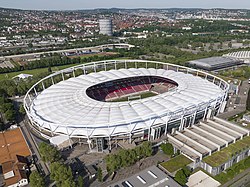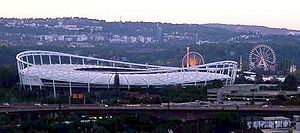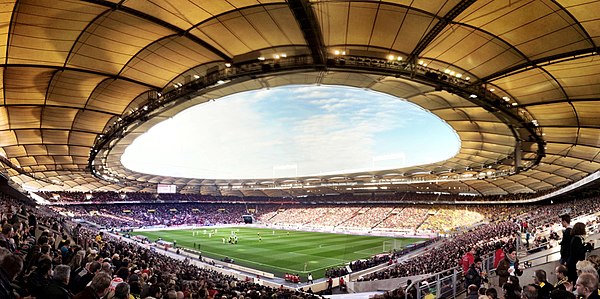MHPArena
 | |
 | |
| Former names | Stuttgarter Kampfbahn (1929–1933)[3] Adolf-Hitler-Kampfbahn (1933–1945) Century Stadium (1945–1949) Neckarstadion (1949–1993) Gottlieb-Daimler-Stadion (1993–2008) Mercedes-Benz Arena (2008–2023) |
|---|---|
| Address | Mercedesstraße 87, 70372 |
| Location | Stuttgart, Baden-Württemberg, Germany |
| Owner | Stadion NeckarPark GmbH & Co.KG |
| Operator | VfB Stuttgart Arena Betriebs GmbH |
| Capacity | 60,449[7] (league matches), 54,906 (international matches) |
| Record attendance | 97,553 (Germany vs. Switzerland, 22 November 1950) |
| Surface | natural grass |
| Construction | |
| Built | 1929–1933[3] |
| Opened | 23 July 1933 |
| Renovated | 1949–1951, 1999–2003, 2004–2005 ('asp' architekten Stuttgart) |
| Expanded | 1993, 2009–2011 ('asp' architekten Stuttgart) |
| Construction cost | €63.5 million (2009–2011 expansion)[4] €58 million (2004–2005 renovation)[5] €5.2 million (2001)[6] |
| Architect | Paul Bonatz/Friedrich Scholer (1929–1933) 'asp' architekten Stuttgart (2004–2005, 2009–2011) |
| Project manager | Stefan Heim, Martin Rau |
| Tenants | |
| VfB Stuttgart (1933–present) Germany national football team (selected matches)
| |
| Website | |
| www | |
The MHPArena (German pronunciation:
Before 1993 it was called the Neckarstadion ([ˈnɛkaʁˌʃtaːdi̯ɔn] ⓘ), named after the nearby river Neckar. Between 1993 and July 2008 it was called the Gottlieb-Daimler-Stadion [ˌɡɔtliːpˈdaɪmlɐˌʃtaːdi̯ɔn]. The stadium was renamed the Mercedes-Benz Arena at the beginning of the 2008–09 season, starting with a pre-season friendly against Arsenal on 30 July 2008.[8] On 1 July 2023, the stadium was renamed the MHPArena.[2][1]
History
The stadium was originally built from 1929 to 1933 with the name "Stuttgarter Kampfbahn" after designs by German architects Paul Bonatz and Friedrich Scholer.[3] After it was built, it was named "Adolf-Hitler-Kampfbahn" (pronounced [ˌadɔlfˈhɪtlɐˌkampfbaːn]). From 1945 to 1949 it was called Century Stadium and later Kampfbahn and was used by US Troops to play baseball. The name Neckarstadion was used since 1949.[9] It is home to VfB Stuttgart in the Bundesliga (and to the Stuttgarter Kickers when they played in the Bundesliga).
After a major refurbishment in the late 1980s and early 1990s partly financed by
The stadium capacity was temporarily reduced to around 42,300, after one stand (Untertürkheimer Kurve) was demolished during summer 2009 in the process of converting it to a pure football arena. The rebuilt arena was completed in November 2011 with a new capacity of 60,449, including terracing. Due to UEFA regulations, which only allow seating, the capacity is reduced to around 55,000 during international football matches.[12]

It is divided into four sections,
- the Haupttribüne (main stands), adjacent to Mercedesstraße, housing VIP-lounges and press seats[citation needed]
- the Gegentribüne (opposite stands), formerly named EnBW-Tribüne[13] and Kärcher-Tribüne after some of VfB Stuttgart's sponsors.[14]
- the Cannstatter Kurve (
- the Untertürkheimer Kurve (Untertürkheim Curve), to the right of the Haupttribüne, housing lounges, the blocks for the guest team's fans and the second video wall[16]
The
International matches
The Neckarstadion hosted four matches of the
The stadium also hosted the finals of the
Trivia

- Germany's first international football match after World War II in 1950 (against Switzerland) was played at the stadium. The official match attendance of 96,400 is the stadium record. Journalists estimated that more than 100,000 people attended the match.[22] The first match with players from West and East Germany after the German reunification in 1990 (also versus Switzerland) took place at the Neckarstadion as well.[23]
- ARD Goal of the Century" here against the Swiss in 1977, with a bicycle kick ("Fallrückzieher").[24]
- With 115 m2 each, the stadium's two video walls before rebuilding were the largest in Europe.[18]
- The Gottlieb-Daimler-Stadion was one of the four stadiums hosting games during the
Sports other than football
The 1986
Renovations and redevelopment into football-specific stadium

In 1993 the fabric roof of the stadium was constructed. From 1999 to 2003 the upper tier of the main stand was demolished and rebuilt. In 2005 the opposite stands received a new upper tier as well.[28]
The redevelopment into a football-specific stadium was announced along with the stadium's name change in late March 2008. The first computer images of the new arena were released at the same time, also showing a large cube with four video scoreboards above the centre circle, similar to the one in the
Starting in 2009, the Mercedes-Benz Arena has been redeveloped into a football-specific stadium. New stands were constructed, after the running track was demolished and the pitch level was lowered by 1.30 metres in time for the beginning of the 2009–10 season. Both curves were completely demolished and rebuilt closer to the pitch during the next two years.[28] After the interior redevelopment finished, the roof was expanded to cover all the new rows of the seats. The entire construction was completed by the end of 2011.[12]
Within the first couple of weeks of the redevelopment, 18 undetonated bombs left over from
In June 2022 the lower tier of the main stand was demolished and the reconstruction started.[31]
International tournaments matches
This section needs additional citations for verification. (February 2024) |
All times local (CET)
1974 FIFA World Cup
Stuttgart hosted the following matches at the 1974 FIFA World Cup:
| Date | Time (CET) | Team #1 | Res. | Team #2 | Round | Attendance |
|---|---|---|---|---|---|---|
| 15 June 1974 | 18:00 | Poland |
3–2 | Group 4 | 32,700 | |
| 19 June 1974 | 19:30 | Argentina |
1–1 | Group 4 | 70,100 | |
| 23 June 1974 | 16:00 | Poland |
2–1 | Group 4 | 70,100 | |
| 26 June 1974 | 19:30 | Sweden |
0–1 | Group B | 44,955 |
UEFA Euro 1988
These UEFA Euro 1988 matches were played in Stuttgart:
| Date | Time (CET) | Team #1 | Res. | Team #2 | Round | Attendance |
|---|---|---|---|---|---|---|
| 12 June 1988 | 15:30 | England |
0–1 | Group 2 | 51,373 | |
| 22 June 1988 | 20:15 | Soviet Union |
2–0 | Semi-finals | 61,606 |
2006 FIFA World Cup

The following games were played at the stadium during the 2006 FIFA World Cup:
| Date | Time (CET) | Team #1 | Res. | Team #2 | Round | Attendance |
|---|---|---|---|---|---|---|
| 13 June 2006 | 18:00 | France |
0–0 | Group G | 52,000 | |
| 16 June 2006 | 18:00 | Netherlands |
2–1 | Group C | 52,000 | |
| 19 June 2006 | 21:00 | Spain |
3–1 | Group H | 52,000 | |
| 22 June 2006 | 21:00 | Croatia |
2–2 | Group F | 52,000 | |
| 25 June 2006 | 17:00 | England |
1–0 | Round of 16 | 52,000 | |
| 8 July 2006 | 21:00 | Germany |
3–1 | Third place match | 52,000 |
UEFA Euro 2024
The stadium will host four group stage matches and one quarter-finals match at the UEFA Euro 2024:
| Date | Time | Team #1 | Res. | Team #2 | Round | Attendance |
|---|---|---|---|---|---|---|
| 16 June 2024 | 18:00 | Slovenia |
Match 6 | Group C | ||
| 19 June 2024 | 18:00 | Germany |
Match 14 | Group A | ||
| 23 June 2024 | 21:00 | Scotland |
Match 26 | |||
| 26 June 2024 | 18:00 | Ukraine |
Match 34 | Group E | ||
| 5 July 2024 | 18:00 | Winner match 39 | Match 45 | Winner match 37 | Quarter-finals |
UEFA Club Competition Finals
| Date | Winners | Result | Runners-up | Round | Attendance |
|---|---|---|---|---|---|
| 3 June 1959 | 2–0 | 1959 European Cup final | 72,000 | ||
| 5 September 1962 | 3–0 | 1962 European Cup Winners' Cup final (Replay) | 38,120 | ||
| 25 May 1988 | 0–0 (6–5 pen.) | 1988 European Cup final | 64,000 |
Concerts
Pink Floyd performed at the stadium on 25 June 1989 as part of their 1989 Another Lapse European Tour (A Momentary Lapse of Reason Tour).[32]
English rock band Genesis continued their Turn It On Again: The Tour at the stadium in a sold-out crowd of 50,736 fans in attendance.[33]
See also
References
- ^ a b "Porsche, MHP and VfB Stuttgart AG sign position paper". porsche.com. Porsche. 27 June 2023. Retrieved 1 July 2023.
- ^ a b "Alliance of global brands for VfB". vfb.de. VfB Stuttgart. 27 June 2023. Retrieved 27 June 2023.
- ^ a b c "Das Stuttgarter Stadion im Wandel der Zeit". stuttgarter-nachrichten.de (in German). Stuttgarter Nachrichten. 28 June 2023. Retrieved 23 December 2023.
- ^ Mercedes-Benz Arena Stuttgart. Archived 18 July 2011 at the Wayback Machine. ASP Architekten Arat.
- ^ Gottlieb-Daimler-Stadion Fußball-Weltmeisterschaft 2006. Archived 18 July 2011 at the Wayback Machine. ASP Architekten Arat.
- ^ Parkhaus Gottlieb-Daimler-Stadion Stuttgart. Archived 18 July 2011 at the Wayback Machine. ASP Architekten Arat.
- ^ "Mercedes-Benz Arena – StadiumDB.com". stadiumdb.com. Retrieved 4 August 2019.
- ^ Arsenal: Friendly against VfB Stuttgart announced Archived 18 November 2015 at the Wayback Machine
- ^ "Stuttgart-Bad Cannstatt: Neckarstadion 1953". leo-bw.de (in German). LEO-BW. Retrieved 14 February 2024.
- ^ "Mercedes-Benz Classic: November 1885: Daimler riding car travels from Cannstatt to Untertürkheim". Daimler. 25 October 2010. Archived from the original on 25 February 2014. Retrieved 22 February 2014.
- ^ "Mercedes-Benz Museum – how to find us" (PDF). Mercedes-Benz. Retrieved 22 February 2014.
- ^ a b c "Chronik Umbau 2009-2011". mhparena-stuttgart.de (in German). Retrieved 14 February 2024.
- ^ "EnBW sponsert künftig die VfB-Jugend". stuttgarter-nachrichten.de (in German). Stuttgarter Nachrichten. 9 July 2013. Retrieved 16 February 2024.
- ^ "Beendet Kärcher sein Sponsoring beim VfB Stuttgart?". zvw.de (in German). Zeitungsverlag Waiblingen. 13 December 2021. Retrieved 16 February 2024.
- ^ "Die Fans des VfB: Von A-Block bis Ultras". stuttgarter-zeitung.de (in German). Stuttgarter Zeitung. 9 September 2018. Retrieved 14 February 2024.
- ^ "Blockplan". mhparena-stuttgart.de (in German). Retrieved 16 February 2024.
- ^ "Stuttgarter bedachen Fußball-WM". stuttgarter-zeitung.de (in German). Stuttgarter Zeitung. 25 April 2010. Retrieved 15 February 2024.
- ^ a b "Technical data". sports department of the city administration of Stuttgart. Archived from the original on 21 December 2008. Retrieved 21 December 2008.
{{cite web}}: CS1 maint: unfit URL (link) - ^ "Chronik". mhparena-stuttgart.de (in German). Retrieved 16 February 2024.
- ^ "Diese WM- und EM-Spiele fanden schon in Stuttgart statt". stuttgarter-zeitung.de (in German). Stuttgarter Zeitung. 11 May 2022. Retrieved 16 February 2024.
- ^ "List of UEFA Champions League past winners: Year-by-year results". nbcsports.com. NBC Sports. 21 September 2023. Retrieved 16 February 2024.
- ^ "Vor 70 Jahren: Das erste Länderspiel nach dem Krieg". dfb.de (in German). German Football Association. 22 November 2020. Retrieved 14 February 2024.
- ^ "Premiere in Stuttgart: Wir sind eins". dfb.de (in German). German Football Association. 19 December 2015. Retrieved 16 February 2024.
- ^ "Klaus Fischer erzielt Fußballtor des Jahrhunderts". br.de (in German). Bayerischer Rundfunk. 16 November 2023. Retrieved 16 February 2024.
- ^ "Stadionnamen - Bitte kauf mich!". spiegel.de (in German). Der Spiegel. 16 March 2005. Retrieved 16 February 2024.
- ^ "Ende der Laufbahn". tagesspiegel.de (in German). Der Tagesspiegel. 13 September 2008. Retrieved 16 February 2024.
- ^ "So schick ist das neue VfB-Stadion". stuttgarter-nachrichten.de (in German). Stuttgarter Nachrichten. 5 August 2011. Retrieved 16 February 2024.
- ^ a b "So hat sich die Arena über die Jahrzehnte verändert". stuttgarter-zeitung.de (in German). Stuttgarter Zeitung. 27 December 2022. Retrieved 2 July 2023.
- ^ Groundwork set for stadium re-construction Archived 26 February 2014 at the Wayback Machine
- ^ Deutschland deine Stadien Archived 29 September 2012 at the Wayback Machine (in German) Weltfussball.de - Article on the redevelopment of football stadiums in Germany, accessed: 9 July 2009
- ^ "Modernisierung der Mercedes-Benz-Arena: Was sich für VfB-Fans verändern wird". zvw.de (in German). Zeitungsverlag Waiblingen. 3 June 2022. Retrieved 2 July 2023.
- ^ "Pink Floyd 25.6.1989 Stuttgart, Neckarstadion". pulse-and-spirit.com (in German). Retrieved 16 February 2024.
- ^ "Billboard" (PDF). Americanradiohistory.com. 18 August 2007. p. 12. Retrieved 16 February 2024.
- ^ "Depeche Mode 2013". mhparena-stuttgart.de (in German). Retrieved 16 February 2024.

